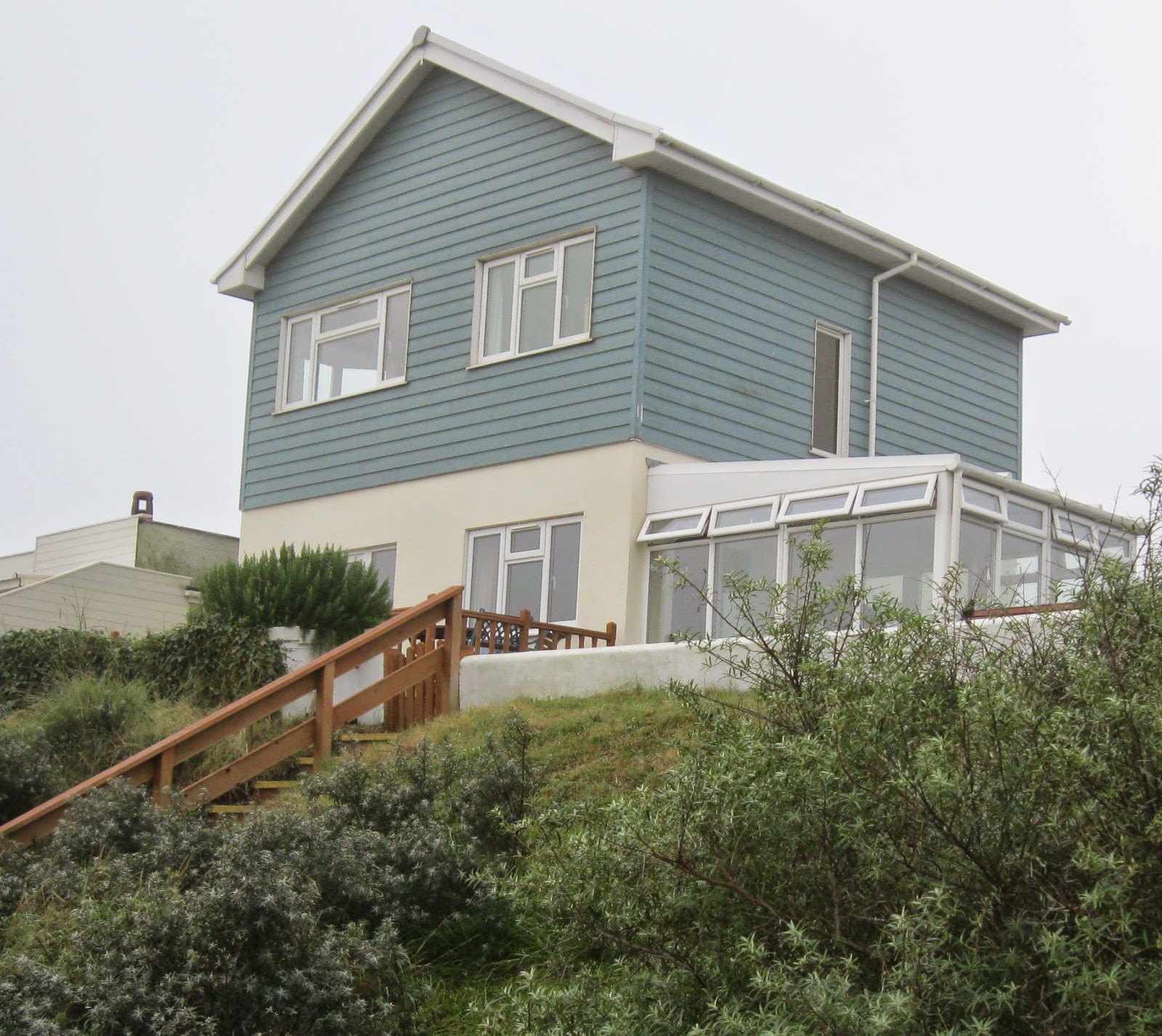Even in the murk and mist of Saturday mid-morning, its plumage looked superb - pleased that it was an adult bird, not a juvenile.
On arrival, I looked in the wrong place - the caravan park close to the foreshore car park. Plenty of starlings on an overhead wire, but not a pink'un among them.
However, I didn't have to wait long following a 300-metre walk inland to Occupation Lane. After three or four minutes, it flew out of a garden and perched for several minutes on wires above the first bungalow at the junction with the street known as The Court.
That seemed to be its favourite vantage point for most of the morning except visits to bird tables in neighbouring gardens.
It didn't behave like a rare bird - ie, it didn't skulk!
In fact it made itself so conspicuous that, to be honest, it offered no challenge at all! But it was still a memorable sighting.
Unfortunately a leaf or two got in the way and the light was poor - but it's definitely a rosy-coloured!
The rare visitor attracted a steady stream of visitors over the weekend
ANOTHER CURIOSITY NEARBY
In the hawthorn hedge on the other side of the road from the entrance to Occupation Lane was a partially white blackbird, feeding on berries. The bird was remarkably tame.
PLENTY OF BIRDING POTENTIAL
ANDERBY Creek isn't really on the radar of many birders, but there's a lot going for it.
The expanse of buckthorn surely provides temporary refuge for plenty of migrants and it seems a good place for sea watching (but not on a misty morning).
What's more it provides two viewing points for birders - the "cloud bar" and the "bird hide".
Both were probably devised as cultural rather ornithological "projects", but they offer birders the opportunity for a bird's eye view of birds - useful, for instance, if you want to assure yourself that a goldcrest isn't a firecrest.
Re the "bird hide", were any bird/wildlife organisations consulted about its design and location?
The bird hide - decent panoramic views, especially from the top
The cloud bar - not as well located as the bird hide but it provides good views over the buckthorn
A warm welcome offered to all - Anderby Creek's shop and cafe
Helping to promote eco-tourism - the county council's coastal country park project
BUZZARDS ON THE INCREASE
Twenty years ago, sightings of buzzards were relatively few and far between in East Lincolnshire, but how times have changed!
Just last week, I saw three together soaring over plough fields at the coast end of South Sea Lane in Humberston, one over the Cleethorpes saltmarsh and and another over the Station Road allotments in Waltham.
Great news (except for rabbits). But is the success of the buzzard blocking the progress of the red kite, a species whose expansion seems to have faltered, at least in North East Lincolnshire?
Are the two species in competiton for nesting and feeding habitat?
WHY SO FEW SLOES?
Do any birds eat sloeberries?
Even though Lincolnshire's numerous blackthorn bushes are full of distinctive white flowers in March and April, those bearing sloes seem few and far between.
Are they being eaten in late summer by wood pigeons, magpies or other birds - or is it just a fact of nature that few blackthorn flowers develop into sloes?
DECLINE OF THE SONG THRUSH
Has the song thrush been lost as a breeding species to some parts of Lincolnshire - notably in the north-east of the county?
Tragically, I fear this may be the case. Back in February, I heard one singing near Pleasure Island amusement park in Cleethorpes, but have neither heard nor seen one since in the resort.
Gutted!
HOLDING ITS OWN
By contrast, its much brasher and feistier cousin, the mistle thrush, seems to be holding its own.
At this time of the year, two or three are often to be seen feeding on the golf course at Bourne Leisure's Thorpe Park holiday site adjacent in Humberston.
The blend of grey and brown plumage is somewhat reminiscent of the wryneck. In fact, if the mistle thrush was smaller and barred instead of speckled, there would not be so much difference between the two species.
GREBES GALORE!
Happy to see no fewer than seven little grebes on Friday at the nearby Fitties pools bordering the RSPB's Tetney Marshes reserve. Here's hoping that the onset of winter will see a return of rarer cousins such as Slavonian or even the black-necked that spent a few days at the same site in early spring.








No comments:
Post a Comment